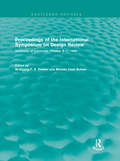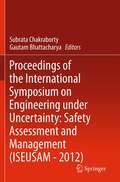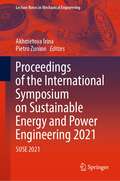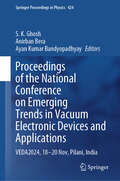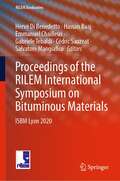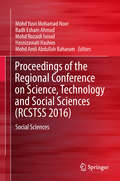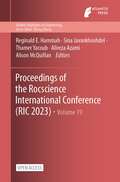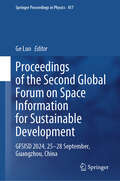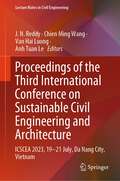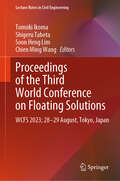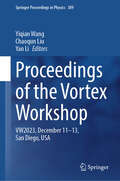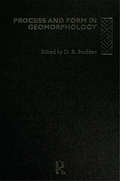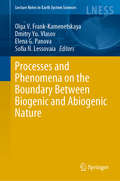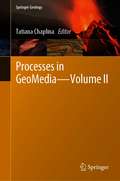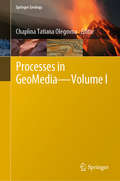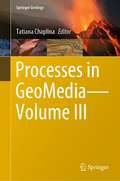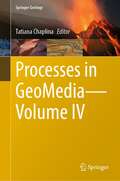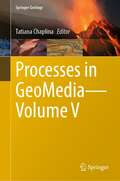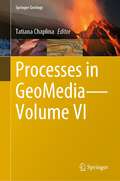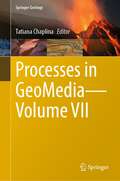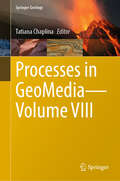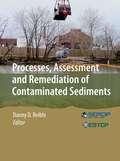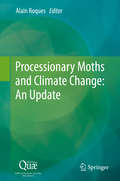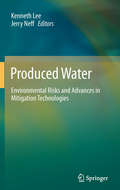- Table View
- List View
Proceedings of the International Symposium on Design Review: University of Cincinnati, October 8-11, 1992 (Routledge Revivals)
by Wolfgang F.E. Preiser Brenda Case ScheerFirst published in 1992, this book collects together the papers presented at the International Symposium on Design Review which was held to address the growing tendency of local governments to institute programs of aesthetic control. The editor argues that the widespread adoption of design review processes in the years preceding the conference necessitated thoroughgoing professional criticism and a number of areas of debate are identified and addressed in the subsequent papers. Are the difficulties experienced by planners, community activists and architects with the process due to its relative youth or inherent flaws in the entire concept? How should mechanical problems like time and expense, the ease with which the process can be manipulated, and general inefficiencies in the system be resolved? More intricate problems are also addressed, such as: who has the power to judge the aesthetic quality of a building, whether design review infringes on the rights of the individual especially under the First Amendment, whether the design review process is "fair", and the difficulty for the reviewer of deciding what is right and what is wrong having taken into account factors that can be highly subjective or contradict more practical concerns.
Proceedings of the International Symposium on Engineering under Uncertainty: Safety Assessment and Management (ISEUSAM - #2012)
by Gautam Bhattacharya Subrata ChakrabortyInternational Symposium on Engineering under Uncertainty: Safety Assessment and Management (ISEUSAM - 2012) is organized by Bengal Engineering and Science University, India during the first week of January 2012 at Kolkata. The primary aim of ISEUSAM 2012 is to provide a platform to facilitate the discussion for a better understanding and management of uncertainty and risk, encompassing various aspects of safety and reliability of engineering systems. The conference received an overwhelming response from national as well as international scholars, experts and delegates from different parts of the world. Papers received from authors of several countries including Australia, Canada, China, Germany, Italy, UAE, UK and USA, besides India. More than two hundred authors have shown their interest in the symposium. The Proceedings presents ninety two high quality papers which address issues of uncertainty encompassing various fields of engineering, i.e. uncertainty analysis and modelling, structural reliability, geotechnical engineering, vibration control, earthquake engineering, environmental engineering, stochastic dynamics, transportation system, system identification and damage assessment, and infrastructure engineering.
Proceedings of the International Symposium on Sustainable Energy and Power Engineering 2021: SUSE 2021 (Lecture Notes in Mechanical Engineering)
by Akhmetova Irina Pietro ZuninoThis book comprises the proceedings of the International Symposium on Sustainable Energy and Power Engineering (SUSE) 2021. The contents of this volume focus on recent technological advances in the field of energy efficiency and green buildings, new construction materials and related technology, hydrogen and renewable energy, environmental aspects of the modern power industry, etc. The contents cover latest advances especially in digital transformation of society and economy of the energy sector, turbomachines and combined plants, intelligent energy systems. This volume will prove a valuable resource for those in academia and industry.
Proceedings of the National Conference on Emerging Trends in Vacuum Electronic Devices and Applications: VEDA2024, 18-20 Nov, Pilani, India (Springer Proceedings in Physics #424)
by S. K. Ghosh Anirban Bera Ayan Kumar BandyopadhyayThis book presents peer reviewed articles from the Conference on Vacuum Electronic Devices Applications (VEDA2024) held at Pilani in India. Like its previous editions, it focusses on new ideas and the latest developments in research and industry on topics like technologies for vacuum electron devices (VEDs) or Systems and Subsystems employing VEDs, RF, HPM, and THz Components, Devices & Systems, RF, MW & mm-wave, Antennas and EM Simulations, Materials, power systems and components for VEDs, High emission density cathodes for VEDs, Applications of VEDs, Future trends & competing technologies. It brings together scientists, industrialists, academicians, and research scholars to exchange ideas and present latest developments in the field.
Proceedings of the RILEM International Symposium on Bituminous Materials: ISBM Lyon 2020 (RILEM Bookseries #27)
by Hervé Di Benedetto Gabriele Tebaldi Hassan Baaj Emmanuel Chailleux Cédric Sauzéat Salvatore MangiaficoThis volume highlights the latest advances, innovations, and applications in bituminous materials and structures and asphalt pavement technology, as presented by leading international researchers and engineers at the RILEM International Symposium on Bituminous Materials (ISBM), held in Lyon, France on December 14-16, 2020. The symposium represents a joint effort of three RILEM Technical Committees from Cluster F: 264-RAP “Asphalt Pavement Recycling”, 272-PIM “Phase and Interphase Behaviour of Bituminous Materials”, and 278-CHA “Crack-Healing of Asphalt Pavement Materials”. It covers a diverse range of topics concerning bituminous materials (bitumen, mastics, mixtures) and road, railway and airport pavement structures, including: recycling, phase and interphase behaviour, cracking and healing, modification and innovative materials, durability and environmental aspects, testing and modelling, multi-scale properties, surface characteristics, structure performance, modelling and design, non-destructive testing, back-analysis, and Life Cycle Assessment. The contributions, which were selected by means of a rigorous international peer-review process, present a wealth of exciting ideas that will open novel research directions and foster new multidisciplinary collaborations.
Proceedings of the Regional Conference on Science, Technology and Social Sciences: Social Sciences (RCSTSS #2016)
by Badli Esham Ahmad Mohd Yusri Mohamad Noor Mohd Rozaidi Ismail Hasnizawati Hashim Mohd Amli Abdullah BaharumThis book features papers addressing a broad range of topics including psychology, religious studies, natural heritage, accounting, business, communication, education and sustainable development. It serves as a platform for disseminating research findings by academicians of local, regional and global prominence, and acts as a catalyst to inspire positive innovations in the development of the region. It is also a significant point of reference for academicians and students. This collection of selected social sciences papers is based on the theme “Soaring Towards Research Excellence”, presented at the Regional Conference of Sciences, Technology and Social Sciences (RCSTSS 2016), organised bi-annually by Universiti Teknologi MARA Cawangan Pahang, Malaysia.
Proceedings of the Rocscience International Conference 2023 (Atlantis Highlights in Engineering #19)
by Alison McQuillan Thamer Yacoub Reginald E. Hammah Sina Javankhoshdel Alireza AzamiThis is an open access book.Rocscience is delighted to announce the Rocscience International Conference 2023 (RIC2023), an in-person gathering to be held from April 24–26, 2023, in Toronto, Canada. RIC2023's primary objective is to bring geotechnical professionals together to meet and exchange ideas on important issues and developments in geotechnical engineering, particularly combinations of emerging and mature technologies.The geotechnical industry is rapidly evolving. Engineers are more connected through technology, technology is becoming more integrated than ever, and methods combining these technologies are becoming more prevalent. This movement towards combining technologies led us to the conference theme, “Synergy in Geotechnical Engineering – Success Beyond Individual Technologies.” We believe the time is right to highlight how far the industry has come with various technologies and continues to develop. The conference aims to create an environment that fosters new perspectives and helps attendees delve deeper into innovative approaches.During RIC2023, Rocscience will award the 2023 Lifetime Achievement Medal to Dr. Norbert Morgenstern, an internationally recognized authority in the engineering community. As both a practitioner and educator, Dr. Morgenstern’s contributions to the geotechnical community continue to benefit engineers worldwide, and he will give an address on his career.In addition to keynotes by Dr. Morgernstern and four other distinguished speakers, there will be several technical and networking sessions.
Proceedings of the Second Global Forum on Space Information for Sustainable Development: GFSISD 2024, 25–28 September, Guangzhou, China (Springer Proceedings in Physics #417)
by Ge LuoThis proceedings book gathers the latest research presented at the Second Global Forum on Space Information for Sustainable Development (GFSISD 2024) which hosted by China Association of Remote Sensing Application (CARSA), supported by Guangzhou Association For Science & Technology and took place in Guangzhou, Guangdong Province, China, from September 25th to 28th, 2024”. The forum aimed to investigate the important role of remote sensing in fostering environmental conservation and sustainable development. Both the forum and this proceedings volume address interdisciplinary areas including space information, earth system science, social sciences, economics, and sustainable development. It highlights the enhanced application of spatial information and big data derived from remote sensing in areas such as climate change response, disaster risk reduction, food security, energy and resource management, environmental protection, biodiversity preservation, public health, traffic management, and ocean monitoring. The book provides extensive coverage of three specific goals within the United Nations' 2030 Agenda for Sustainable Development: Goal 2—Zero Hunger, which encompasses sustainable agriculture; Goal 14—Life Below Water, which emphasizes the sustainable use of marine resources; and Goal 15—Life On Land, which focuses on the sustainable use of terrestrial ecosystems. Furthermore, the publication covers the methodologies and applications of remote sensing sensors (both optical and radar) that contribute to sustainability efforts. Contributors to these proceedings include distinguished scholars and industry leaders from across the globe. This collection serves as a valuable resource for researchers, students, professionals, and policymakers involved in space science, information science, earth and environmental sciences, and sustainable development.
Proceedings of the Third International Conference on Sustainable Civil Engineering and Architecture: ICSCEA 2023, 19–21 July, Da Nang City, Vietnam (Lecture Notes in Civil Engineering #442)
by J. N. Reddy Chien Ming Wang Van Hai Luong Anh Tuan LeThis book includes articles from the Third International Conference on Sustainable Civil Engineering and Architecture (ICSSEA 2023), held at Da Nang City, Vietnam, on July 19-21, 2023. The conference brings together international experts from both academia and industry to share their knowledge and expertise, facilitate collaboration, and improve cooperation in the field. The book focuses on the most recent developments in sustainable architecture and civil engineering, including offshore structures, structural engineering, building materials, and architecture.
Proceedings of the Third World Conference on Floating Solutions: WCFS 2023; 28–29 August, Tokyo, Japan (Lecture Notes in Civil Engineering #465)
by Chien Ming Wang Soon Heng Lim Tomoki Ikoma Shigeru TabetaThis book includes peer-reviewed articles from the Third World Conference on Floating Solutions WCFS 2023 Japan with an aim to pioneer the SDGs and Next SDGs by making the most use of oceans and water. In recent years, the safety and security of people's lives around the world have been threatened by frequent floods and rising sea levels attributable to climate change. The COP 26 has set a common global goal of limiting the temperature rise to 1.5 degrees Celsius above pre-industrial levels. It is an urgent task to cope with climate change as well as to utilize decarbonized and renewable energy. The UN is promoting the SDGs which aim to achieve 17 Goals between 2015 and 2030. However, efforts to reach the Goals will not end in 2030 but will be an ongoing challenge for humanity beyond 2030. Here, we tentatively call the Goals to be achieved after the SDGs as "Next SDGs." Ocean and water have the potential to provide solutions to the disasters such as flooding and sea level rise due to climate change. In this context, WCFS 2023 presents ocean and water as the urban infrastructure and explores new technology and feasible solutions. In particular, it is necessary to consider urban planning, marine architecture, port planning connecting land and sea, disaster prevention, renewable energy, and food production on the sea and water. Further, it is indispensable that knowledge, experience, dream, and strong desire to realize these challenges are supported by a diversity of people.
Proceedings of the Vortex Workshop: VW2023, December 11-13, San Diego, USA (Springer Proceedings in Physics #254)
by Yan Li Chaoqun Liu Yiqian WangWritten by the leading experts in the field, this book results from Vortex Workshop 2023 which took place in San Diego, the USA, on December 11–13. Vortex is ubiquitous in the universe such as tornado, hurricane, airplane tip vortex, and even star vortex in Galaxy. Vortices are also building blocks, muscles, and sinews of turbulent flows. A vortex is intuitively recognized as a rotational/swirling motion of fluids but until recently had no rigidly mathematical definition. In 1858, Helmholtz first defined vortex as composed of so-called vortex filaments, which are infinitesimal vorticity tubes, which is called as the first generation of vortex definition and identification, or G1. Although G1 has been accepted by the fluid dynamics community and almost all textbooks for over a century, we can find many immediate counterexamples, for example, in the laminar boundary layer, where the vorticity (shear) is very large near the wall, but not rotation (no vortex) exists. To solve these contradictions, many vortex criteria methods have been developed during the past 4 decades. More popular methods are represented by the Q, ∆, criteria methods. These methods have achieved part of success in vortex identification, which are called the second generation of vortex identification or G2. However, G2 has several critical drawbacks. First, they are all scalars which have no rotation axis directions, but vortex is a vector. It is hard or impossible to use a scalar to represent a vector. Second, like vorticity, these criteria methods are all contaminated by shear in different degrees. Third, they are all very sensitive on threshold selections. The recently developed Liutex is called the third generation of vortex definition and identification, or G3, which is a uniquely defined vector.
Proceedings of the XIII International Scientific Conference on Architecture and Construction 2020: Commemorating the 90th anniversary of Novosibirsk State University of Architecture and Civil Engineering (Lecture Notes in Civil Engineering #130)
by Angela MottaevaThe book contains the latest studies on digitalization of transport and logistics, improving vehicle fuel efficiency, information technology and digital security, land management and cadastres, building structures, structural analysis, and energy conservation in construction. This book consists of papers presented during the XIII International Scientific Conference on Architecture and Construction 2020, which is dedicated to the 90th anniversary of Novosibirsk State University of Architecture and Civil Engineering, held on September 22–24, 2020. The book caters to researchers, scientists and industrial practitioners in the field of transportation engineering, logistics, intelligent transport systems, sustainable construction for housing and industrial buildings.
Process and Form in Geomorphology
by David StoddartProcess and Form in Geomorphology marks a turning point in geomorphological research. Stoddart has brought together a team of the leading international experts to offer important new studies into the processes, theory and history of landforms, and to present a framework for taking research forward into the new millenium. Illustrated throughout, Process and Form in Geomorphology takes up the challenges of the research agenda set by Richard Chorley and offers fresh insights into his unique contribution.
Processes and Phenomena on the Boundary Between Biogenic and Abiogenic Nature (Lecture Notes in Earth System Sciences)
by Olga V. Frank-Kamenetskaya Elena G. Panova Dmitry Yu. Vlasov Sofia N. LessovaiaThe book represents a collection of papers presented at VI International Symposium "Biogenic - abiogenic interactions in natural and anthropogenic systems" that was held on 24-27 September 2018 in Saint Petersburg (Russia). Papers in this book cover a wide range of topics connecting with interactions between biogenic and abiogenic components in lithosphere, biosphere and technosphere. The main regarding topics are following: methods for studying the interactions between biogenic and abiogenic components; geochemistry of biogenic-abiogenic systems; biomineralization and nature-like materials and technologies; medical geology; biomineralogy and organic mineralogy; biomineral interactions in soil; biodeterioration of natural and artificial materials; biomineral interactions in extreme environment.
Processes in GeoMedia - Volume II (Springer Geology)
by Tatiana ChaplinaThis book presents the findings of recent theoretical and experimental studies of processes in the atmosphere, oceans, and lithosphere, discussing their interactions, geology. methods of geophysical research, and environmental problems resulting from human impacts. Particularly focusing on the geomechanical aspects of the production of hydrocarbons, including the laborious extraction of oils, it also includes contributions on ecological problems related to the biosphere.
Processes in GeoMedia—Volume I (Springer Geology)
by Chaplina Tatiana OlegovnaThis book presents the findings of recent theoretical and experimental studies of processes in the atmosphere, oceans and lithosphere, discussing their interactions, environmental issues, geology, problems related to human impacts on the environment, and methods of geophysical research. It particularly focuses on the geomechanical aspects of the production of hydrocarbons, including the laborious extraction of oils. Furthermore, it includes contributions on ecological problems of the biosphere.
Processes in GeoMedia—Volume III (Springer Geology)
by Tatiana ChaplinaThis book presents the findings of recent theoretical and experimental studies of processes in the atmosphere, oceans and lithosphere, discussing their interactions, environmental issues, geology, problems related to human impacts on the environment, and methods of geophysical research. It particularly focuses on the geomechanical aspects of the production of hydrocarbons, including the laborious extraction of oils. Furthermore, it includes contributions on ecological problems of the biosphere. This book corresponds to the English edition of the "Processes in GeoMedia," a Russian academic journal focused on new theoretical and experimental studies of the Earth's processes.
Processes in GeoMedia—Volume IV (Springer Geology)
by Tatiana ChaplinaThis book corresponds to the fourth volume of the series focused on Processes in GeoMedia and their research on the dynamic of natural systems - geosphere, hydrosphere, atmosphere, and their interactions-, the human contribution to naturally occurring processes are among the most urgent and essential scientific problems. The widespread introduction of computer technology has allowed calculating complex phenomena, previously unavailable for analysis. The creation and improvement of a new generation of geophysical instruments, remote observing systems based on the ship, aircraft, and satellite allow obtaining a large amount of data to reflect the broad picture of the processes objectively. The articles included in this book also reflect a critical position in laboratory modeling of research in geo-environments and testing.
Processes in GeoMedia—Volume V (Springer Geology)
by Tatiana ChaplinaThis book corresponds to the fifth volume of the series focused on Processes in GeoMedia and their research on the dynamic of natural systems, including theoretical and experimental studies of the processes occurring in the earth's bowels, the ocean, and the atmosphere. This volume pays particular attention to geomechanical aspects of the production of hydrocarbons.This fifth volume of Processes in GeoMedia corresponds to the English edition of the journal Processes in GeoMedia, published originally in Russian.
Processes in GeoMedia—Volume VI (Springer Geology)
by Tatiana ChaplinaThe sixth volume of “Processes in GeoMedia”, connected to the Russian journal with the same name, publishes new results of theoretical and experimental studies of the processes occurring in the bowels of the earth, the ocean, and the atmosphere; particular attention is paid to geomechanical aspects of the production of hydrocarbons, including laboriously extracted oils, and to the ecological problems of the biosphere, the human impact on the environment, methods of geophysical research are within the range of the journal interests.
Processes in GeoMedia—Volume VII (Springer Geology)
by Tatiana ChaplinaThis book includes new results of theoretical and experimental studies of various scales of the processes occurring on the earth including the lithosphere, atmosphere, and hydrosphere. Intensive development of research in these areas is due to several factors: 1) the widespread introduction of computer technology, allowing the calculation of complex phenomena; 2) the invention and improvement of a new generation of geophysical instruments such as remote observation systems based on ships, aircraft, and satellites, providing a large amount of data to objectively reflect a broad picture of the processes; and 3) the development of measurement techniques, creating opportunities for controllable and reproducible laboratory data acquisition for generation of new ideas and concepts. Their recent developments have facilitated our research and understanding of these academic fields. The book enriches the understanding of the geophysical processes taking place in various environments (lithosphere, hydrosphere, and atmosphere), including the anthropogenic one, and it further contributes to their development. This book is a valuable resource for specialists working in the oil, gas, and engineering industry to improve their understandings of the field.
Processes in GeoMedia—Volume VIII (Springer Geology)
by Tatiana ChaplinaThis book includes new results of theoretical and experimental studies of various scales of the processes occurring on the earth including the lithosphere, atmosphere, and hydrosphere. Intensive development of research in these areas is due to several factors: 1) the widespread introduction of computer technology, allowing the calculation of complex phenomena, 2) the invention and improvement of a new generation of geophysical instruments such as remote observation systems based on ships, aircraft, and satellites, providing a large amount of data to objectively reflect a broad picture of the processes, 3) the development of measurement techniques, creating opportunities for controllable and reproducible laboratory data acquisition for generation of new ideas and concepts. Their recent developments have facilitated our research and understanding of these academic fields. The book enriches the understanding of the geophysical processes taking place in various environments (lithosphere, hydrosphere, atmosphere), including the anthropogenic one, and it further contributes to their development. This collected research is a valuable resource for specialists working in the oil, gas, and engineering industry to improve their understandings of the field.
Processes, Assessment and Remediation of Contaminated Sediments
by Danny D. ReibleThe purpose of this book is to help engineers and scientists better understand contaminated sediment sites and identify and design remedial approaches that are more efficient and effective. Contaminated sediment management is a difficult and costly exercise that is rarely addressed with easily identified and implemented remedies. It is hoped that this book can help identify and implement management approaches that provide an optimal, if not entirely satisfactory, solution to sediment contaminant problems.
Processionary Moths and Climate Change: An Update
by Alain RoquesBecause of its peculiar biology, its negative impacts on forestry, and its urticating larvae affecting human and animal health, pine processionary moth has largely been studied in many European countries during the last century. However, knowledge remained scattered and no synthesis has ever been published. Since the IPCC retained the moth as one of the two insect indicators of climate change because of its expansion with warming up, filling this gap became increasingly important. Led by INRA, this book associates 101 authors from 22 countries of Europe, Minor Asia and North Africa, combining all the concerned research fields (entomology, ecology, genetics, mathematical modelling, medical and veterinary science, pest management) in a multidisciplinary approach to understand and model the processes underlying past, present and future moth expansion and to propose adapted management methods. Besides, the major biological patterns of the related processionary species are also detailed.
Produced Water
by Jerry Neff Kenneth LeeA state-of-the-art review of scientific knowledge on the environmental risk of ocean discharge of produced water and advances in mitigation technologies. In offshore oil and gas operations, produced water (the water produced with oil or gas from a well) accounts for the largest waste stream (in terms of volume discharged). Its discharge is continuous during oil and gas production and typically increases in volume over the lifetime of an offshore production platform. Produced water discharge as waste into the ocean has become an environmental concern because of its potential contaminant content. Environmental risk assessments of ocean discharge of produced water have yielded different results. For example, several laboratory and field studies have shown that significant acute toxic effects cannot be detected beyond the "point of discharge" due to rapid dilution in the receiving waters. However, there is some preliminary evidence of chronic sub-lethal impacts in biota associated with the discharge of produced water from oil and gas fields within the North Sea. As the composition and concentration of potential produced water contaminants may vary from one geologic formation to another, this conference also highlights the results of recent studies in Atlantic Canada.
